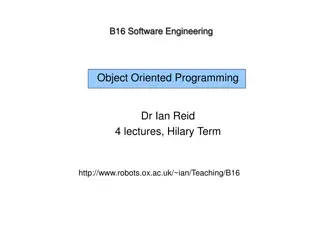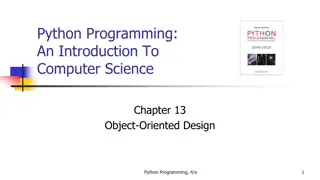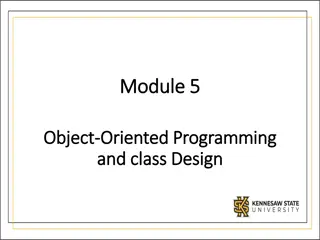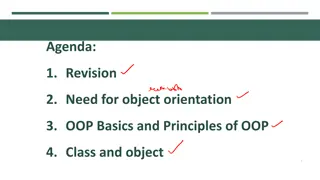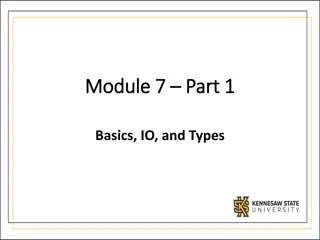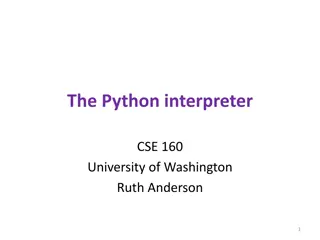Understanding Object-Oriented Programming (OOP) in Python
Python is a versatile programming language that supports various programming approaches. Object-Oriented Programming (OOP) is a popular method in Python where objects are created to solve programming problems. OOP in Python focuses on creating reusable code, following the principle of DRY (Don't Repeat Yourself). Classes act as blueprints for objects, defining their attributes and behaviors. Instances are specific objects created from a class. The __init__() function in Python serves as a constructor for initializing object properties.
Download Presentation

Please find below an Image/Link to download the presentation.
The content on the website is provided AS IS for your information and personal use only. It may not be sold, licensed, or shared on other websites without obtaining consent from the author. Download presentation by click this link. If you encounter any issues during the download, it is possible that the publisher has removed the file from their server.
E N D
Presentation Transcript
Computer Engineering Department Advanced Python Programming(CE0620) Classes and Object- Oriented Programming in Python By Prof. Bhumi Shah
Python Is Object-Oriented Python is a multi-paradigm programming language. It supports different programming approaches. One of the popular approaches to solve a programming problem is by creating objects: known as Object-Oriented Programming (OOP). An object has two characteristics: attributes behavior for example, an object could represent a person with properties like a name, age, and address and behaviors such as walking, talking, breathing, and running.
The concept of OOP in Python focuses on creating reusable code. This concept is also known as DRY (Don't Repeat Yourself).
Class in Python A class is a blueprint for the object. We can think of class as a sketch of a person with labels. It contains all the details about the name, age, and address etc. Based on these descriptions, we can study about the person . The example for class of person can be : class person: pass class keyword is used to define an empty class person. From class, we construct instances. An instance is a specific object created from a particular class.
Object An object (instance) is an instantiation of a class. When class is defined, only the description for the object is defined. Therefore, no memory or storage is allocated. The example for object of person class can be: obj1 = person() Here, obj1 is an object of class person.
Example class person: age = 50 p1 = person() print(p1.age)
__init__() Function built-in __init__() function the method the __init__() simulates the constructor of the class All classes have a function called __init__(), which is always executed when the class is being initiated. The properties that all person objects must have are defined in a method called .__init__(). Every time a new person object is created, .__init__() sets the initial state of the object by assigning the values of the object s properties. It accepts the self-keyword as a first argument which allows accessing the attributes or method of the class. When a new class instance is created, the instance is automatically passed to the self parameter in .__init__() so that new attributes can be defined on the object.
Example class Person: def __init__(self, name, age): self.name = name self.age = age self.name = name creates an attribute called name and assigns to it the value of the name parameter. p1 = Person("ABC", 50) To instantiate objects of this person class, you need to provide values for the name and age. If you don t, then Python raises a TypeError: print(p1.name) print(p1.age) The __init__() function is called automatically every time the class is being used to create a new object. self.age = age creates an attribute called age and assigns to it the value of the age parameter.
Example class Employee: def __init__(self, name, id): self.id = id self.name = name def display(self): print("ID: %d \nName: %s" % (self.id, self.name)) emp1 = Employee("XYZ , 101) emp2 = Employee("ABC", 102) emp1.display() emp2.display()
Instantiate an Object in Python Creating a new object from a class is called instantiating an object. We can instantiate a new person object by typing the name of the class, followed by opening and closing parentheses: person() p1=person()
Instance Methods Instance methods are functions that are defined inside a class and can only be called from an instance of that class. like .__init__(), an instance method s first parameter is always self.
class animal: species = "Canis" def __init__(self, name, age): self.name = name self.age = age # Instance method def description(self): return f"{self.name} is {self.age} years old" # Another instance method def speak(self, sound): return f"{self.name} says {sound}"
.__str__() method When we print(p1), it displays message telling you that p1 is a person object at the memory address 0x00aeff70. This message can be changed what gets printed by defining a special instance method called .__str__(). class person: # Leave other parts of class as-is # Replace .description() with __str__() def __str__(self): return f"{self.name} is {self.age} years old" Note:.__init__() and .__str__() are called dunder methods because they begin and end with double underscores.
Abstract Data Types and Classes The abstract data type is special kind of data type, whose behavior is defined by a set of values and set of operations. The keyword Abstract is used as we can use these data types, we can perform different operations But how those operations are working that is totally hidden from the user. The ADT is made of primitive data types, but operation logics are hidden.
Inheritance The method of inheriting the properties of parent class into a child class is known as inheritance. It is an OOP concept. benefits of inheritance. Code reusability- we do not have to write the same code again and again, we can just inherit the properties we need in a child class. It represents a real world relationship between parent class and child class. It is transitive in nature. If a child class inherits properties from a parent class, then all other sub-classes of the child class will also inherit the properties of the parent class.
Steps To perform inheritance 1. Create a Parent Class Any class can be a parent class, so the syntax is the same as creating any other class class Parent(): 2. Create a Child Class To create a class that inherits the functionality from another class, send the parent class as a parameter when creating the child class class Child(Parent):
Example class Parent(): def first(self): print('Parent s function') class Child(Parent): def second(self): print('Child s function') ob = Child() ob.first() ob.second()
__init__() in inheritance The __init__() function is called every time a class is being used to make an object. When we add the __init__() function, the child class will no longer inherit the parent's __init__() function. The child s class __init__() function overrides the parent class s __init__() function. To keep the inheritance of the parent's __init__() function, we need to add a call to the parent's __init__() function
class Parent: def __init__(self , fname, fage): self.firstname = fname self.age = fage def view(self): print(self.firstname , self.age) class Child(Parent): def __init__(self , fname , fage): Parent.__init__(self, fname, fage) self.lastname = "ChildClass" def view(self): print("child name" , self.firstname ,"has the ", self.age , " age." , self.lastname, ":Testing") ob = Child("XYZ" , '32') ob.view()
Python - Public, Protected, Private Members Public Members:accessible from outside the class. The object of the same class is required to invoke a public method. This arrangement of private instance variables and public methods ensures the principle of data encapsulation. All members in a Python class are public by default.
Example class Student: schoolName = 'XYZ School' # class attribute def __init__(self, name, age): self.name=name # instance attribute self.age=age # instance attribute std = Student("ABC", 25) std.schoolName std.name std.age = 20 std.age
Python - Public, Protected, Private Members Protected Members:Protected members of a class are accessible from within the class and are also available to its sub- classes. No other environment is permitted access to it. This enables specific resources of the parent class to be inherited by the child class. Python's convention to make an instance variable protected is to add a prefix _ (single underscore) to it. This effectively prevents it from being accessed unless it is from within a sub-class.
Example class Student: _schoolName = 'XYZ School' # protected class attribute def __init__(self, name, age): self._name=name # protected instance attribute self._age=age # protected instance attribute std = Student("Swati", 25) std._name std._name = 'Dipa' std._name
Python - Public, Protected, Private Members Private Members: Python doesn't have any mechanism that effectively restricts access to any instance variable or method. Python prescribes a convention of prefixing the name of the variable/method with a single or double underscore to emulate the behavior of protected and private access specifiers. The double underscore __ prefixed to a variable makes it private. It gives a strong suggestion not to touch it from outside the class. Any attempt to do so will result in an AttributeError:
Example class Student: __schoolName = 'XYZ School' # private class attribute def __init__(self, name, age): self.__name=name # private instance attribute self.__age=age # private instance attribute def __display(self): # private method print('This is private method.') std = Student("Bill", 25) std.__schoolName AttributeError: 'Student' object has no attribute '__schoolName' std.__name AttributeError: 'Student' object has no attribute '__name' std.__display() AttributeError: 'Student' object has no attribute '__display'
super() Function The super() builtin method used to call the super claa constructor or methods from the sub class. Allows us to avoid using the base class name explicitly Working with Multiple Inheritance Syntax: super().__init__() super().__init__(arguments) we can also call super class methods super().function1()
Example class A(object): def __init__(self, AName): print(AName, ' is Super Class.') Object represents the base class name from where all classes in Python are derived.Its not compulsory to write it. class B(A): def __init__(self): print('This is Child Class') super().__init__('A') ob=B()
Types of Inheritance in Python There are two types of Inheritance: Single Inheritance Multiple Inheritance Multilevel Inheritance hierarchical inheritance
Single Inheritance When a child class inherits only a single parent class. class Parent: def func1(self): print("this is function one") class Child(Parent): def func2(self): print(" this is function 2 ") ob = Child() ob.func1() ob.func2()
Multiple Inheritance When a child class inherits from more than one parent class. class Parent: def func1(self): print("this is function 1") class Parent2: def func2(self): print("this is function 2") class Child(Parent , Parent2): def func3(self): print("this is function 3") ob = Child() ob.func1() ob.func2() ob.func3()
Problems in Multiple inheritance class Class1: def m(self): print("In Class1") class Class2(Class1): def m(self): print("In Class2") class Class3(Class1): def m(self): print("In Class3") class Class4(Class2, Class3): pass obj = Class4() obj.m()
Problems in Multiple inheritance class A(object): def __init__(self): self.a="a" print(self.a) class B(object): def __init__(self): self.b="b" print(self.b) class C(A,B): def __init__(self): self.c="c" print(self.c) super().__init__() ob=C()
Solution class A(object): def __init__(self): self.a="a" print(self.a) super().__init__() class B(object): def __init__(self): self.b="b" print(self.b) super().__init__() class C(A,B): def __init__(self): self.c="c" print(self.c) super().__init__() ob=C() Object A B C
MRO-Method Resolution Order A method is serched first in current class. if not there,it will continue the search in parents claas from left to right fashion,in depth-first search. 1. search into the child class/sub class before going for the parent class. 2. in base classes ,it search from left to right fashion,in depth-first search. 3. It will not visit any class more than once.
Multilevel Inheritance When a child class becomes a parent class for another child class. class Parent: def func1(self): print("this is function 1") class Child(Parent): def func2(self): print("this is function 2") class Child2(Child): def func3("this is function 3") ob = Child2() ob.func1() ob.func2() ob.func3()


